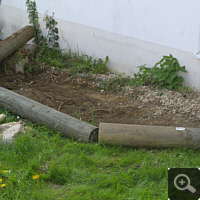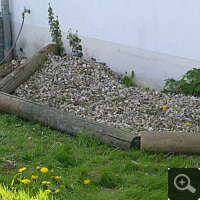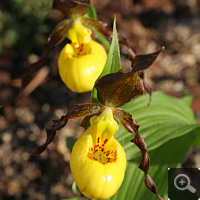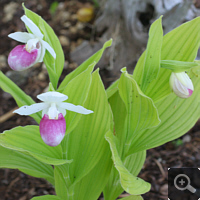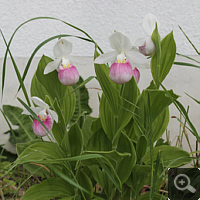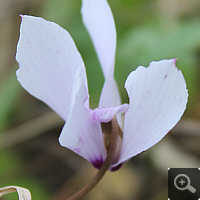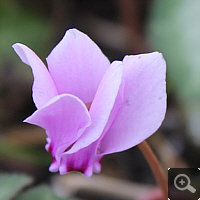Woodland bed
Overview
Shady edges of the garden are often treated as an orphan. But these sites are eminently suited for the construction of a woodland bed, in which for example many beautiful orchids and spring flowering plants can be cultivated.
Neither construction nor annual cultivation are complex or time-consuming.
Project
Explanation of construction and schematic representation
 Shady edges of the garden are suited as location. It covers everything, if these get some sun in the morning or evening for a little while. Many forest dwellers prefer a crumbly, humus-rich soil with a good drainage and a constant moisture at the same time. As a result depending on local conditions must be catered for these needs during construction. On the one hand soil should not dry out even in summer, but in case of stronger rainfall also ensure good drainage. Thus, a multi-layer substrate structure offers.
Shady edges of the garden are suited as location. It covers everything, if these get some sun in the morning or evening for a little while. Many forest dwellers prefer a crumbly, humus-rich soil with a good drainage and a constant moisture at the same time. As a result depending on local conditions must be catered for these needs during construction. On the one hand soil should not dry out even in summer, but in case of stronger rainfall also ensure good drainage. Thus, a multi-layer substrate structure offers.
In the excavated pit, I first poured in a 15 cm high layer of river gravel as drainage. This was followed by an equally high mixture of 2 parts loamy topsoil and one part sharp sand. On the one hand, the intermediate layer should ensure a good drainage in heavy rain, but on the other hand also ensure a sufficient water storage. Next, an approximately 10 cm thick layer of each one third of topsoil, sand and bark mulch follows. In this substrate layer may also plenty of beech leaves will be mixed. To reduce drying out in summer, the bed will eventually be covered with some bark mulch. Finally, the bed is well watered and planted.
The annual maintenance is low. A winter cover with leaves must be done only in frost-sensitive orchids. In hot summers, it may be necessary to water the bed sporadically. From time to time I remove some disturbing growth as too much grass, individual nettles or dandelion plants.
Some plants feel really comfortable in bed and vermehren sich exzessiv, so that they have to be thinned annually. For example became from one wood strawberry plant within two years more than 100 plants. In like manner woodruff has a moderate penchant to sprawl.
If you plant orchids (many species of the genus Cypripedium are easy to cultivate and beautiful), so you should mark the plants. In early spring you clear of carefully (do not damage the underground rhizome!) the planting area from vegetation, so that, a few weeks later, shoots find from the start good conditions for their photosynthesis. In addition, the young orchid bud is very sensitive to slug damage and must initially be protected by a fine wire mesh, if necessary. Once the bud has reached a height of about 15 cm, leaves become hard and protect themselves by thin hairs, so that you can remove the protection.
Suitable plants for an all-year outdoor culture
| genus (botanical) | species (botanical) | English name | comment |
|---|---|---|---|
| Anemone | nemorosa | Wood Anemone | Delicate plant. |
| Bletilla | striata | Hyacinth Orchid | Cover with bark mulch/plastics in winter. |
| Convallaria | majalis | Lily of the Valley | Poisonous! |
| Cyclamen | cilicium | Cilician Cyclamen | Autumn bloomer. Limited hardy! |
| Cyclamen | hederifolium | Ivy-leaved Cyclamen | Autumn bloomer. Winter hardiness better. |
| Cypripedium | formosanum | Formosan Lady’s Slipper | Early bud break. Cover it airy in winter with a plastic plate. |
| Cypripedium | kentuckiense | Kentucky Lady’s Slipper | Very large blossoms. |
| Cypripedium | pubescens | Large Yellow Lady’s Slipper | Similar to C. parviflorum. |
| Cypripedium | parviflorum | Yellow Lady’s Slipper | Similar to C. pubsecens. |
| Cypripedium | reginae | Showy Lady’s-slipper | Quite easy. |
| Fragaria | vesca | Wild Strawberry | Tends to rampant growth. |
| Lamium | galeobdolon | Yellow Archangel | |
| Leucojum | vernum | Spring Snowflake | Prefers moist soils. |
| Primula | elatior | Oxlip | Sulphur-yellow blossoms. |
| Pulmonaria | officinalis | Common Lungwort | Interesting colour change of the blossoms by a change of the pH-value. |

